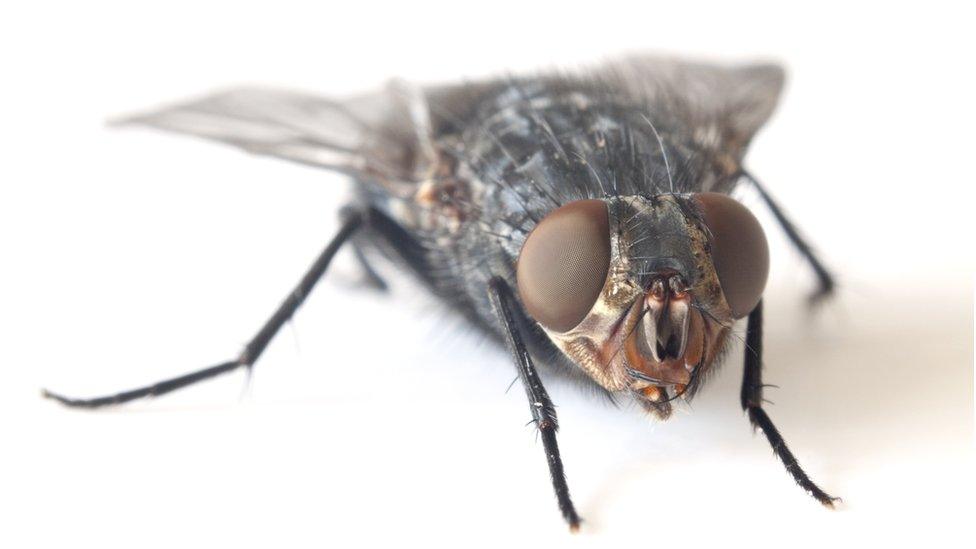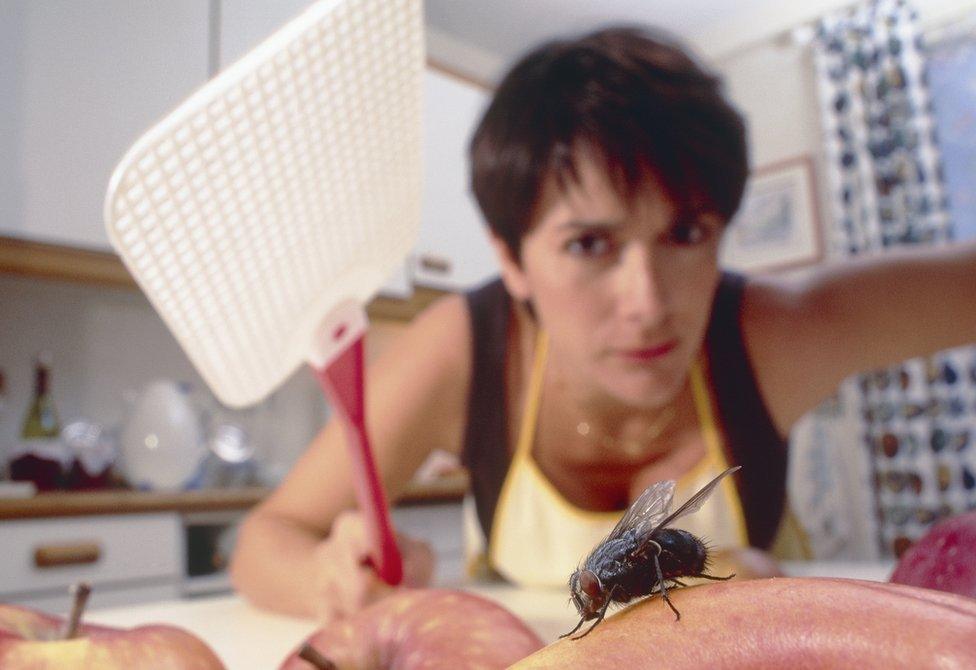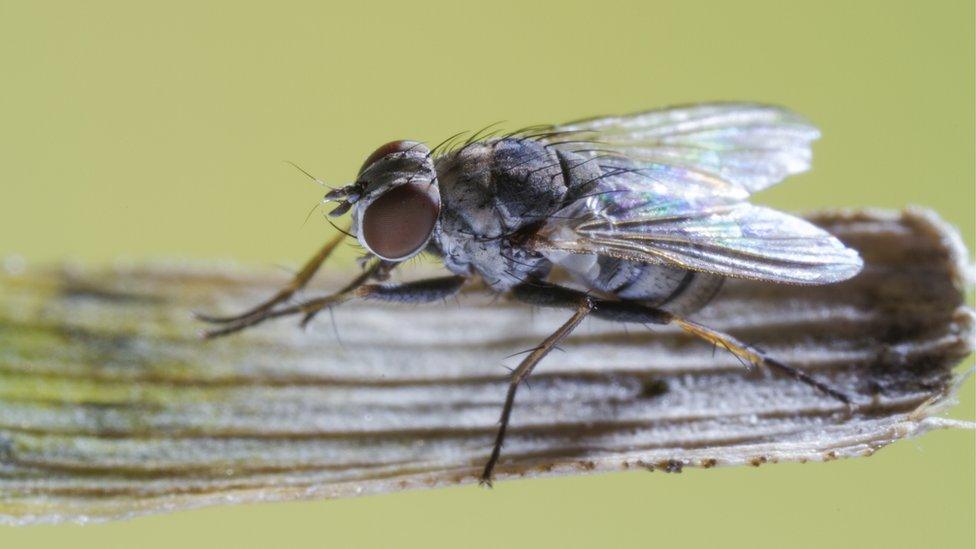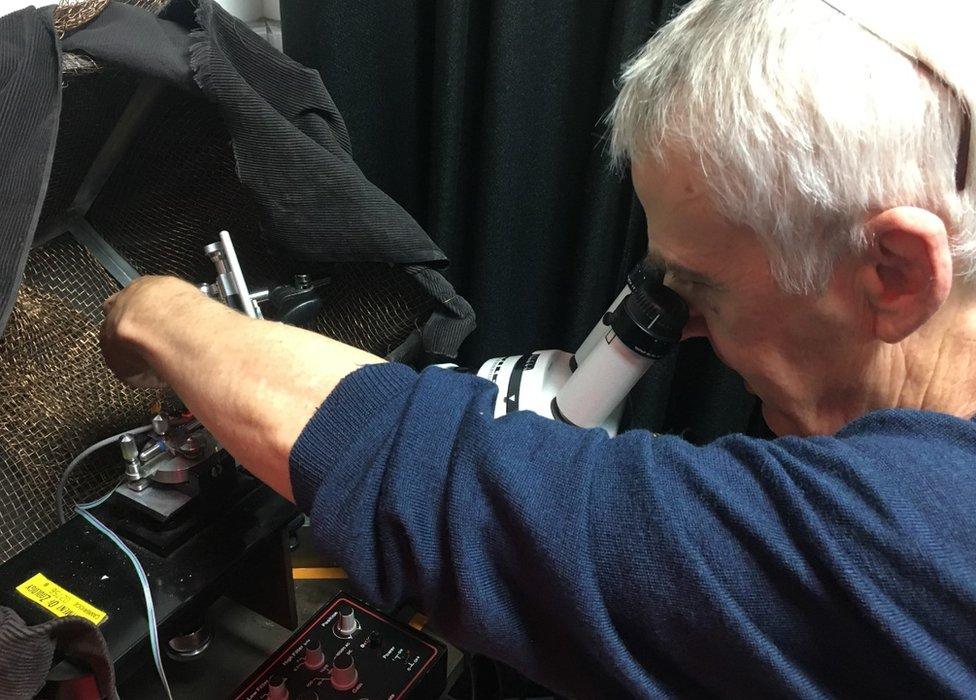Why is it so hard to swat a fly?
- Published

Try to swat a fly and it will soon become clear that they're faster than you. Much faster. But how on Earth do these tiny creatures - with their minuscule brains - outwit us so easily?
You've probably pondered it after chasing a fly around your house and flailing your shoe with repeated, unsuccessful swats. How does it move so fast? Can it read my mind?
It was the question put to the BBC World Service CrowdScience team for our most recent episode addressing the apparent super powers of tiny animals. The answer is that, compared with you and me, flies essentially see the world in slow motion.
To illustrate this, have a look at a clock with a ticking hand. As a human, you see the clock ticking at a particular speed. But for a turtle it would appear to be ticking at twice that speed. For most fly species, each tick would drag by about four times more slowly. In effect, the speed of time differs depending on your species.
This happens because animals see the world around them like a continuous video. But in reality, they piece together images sent from the eyes to the brain in distinct flashes a set number of times per second. Humans average 60 flashes per second, turtles 15, and flies 250.
It's all relative
The speed at which those images are processed by the brain is called the "flicker fusion rate". In general, the smaller the species, the faster its critical flicker fusion rate - and flies, in particular, put us to shame.
Professor Roger Hardie, from the University of Cambridge, investigates how flies' eyes work, and he has an experiment to determine their flicker fusion rate.

"How d'ya like them apples?" For flies, time drags more slowly than for people
"The flicker fusion rate is simply how fast a light has to be turning on and off before it's perceived or seen as just a continuous light" says Prof Hardie.
Roger inserts tiny glass electrodes into the living light sensitive cells of their eyes - photoreceptors - before flashing LED lights at faster and faster speeds. Each flash of the LED produces a tiny electrical current in the photoreceptors that a computer can graph onto a screen. Tests reveal the fastest fly records distinct responses to flickering up to 400 times per second, more than six times faster than our own rate.
The fastest vision of all is found in a species literally called a "killer fly". It's a tiny predatory species found in Europe that catches other flies out of the air with super-fast reactions. In her "fly lab" at Cambridge University, Dr Paloma Gonzales-Bellido demonstrates the killer flies' hunting behaviour by releasing fruit fly prey into a special filming box with a female killer fly.
Some flies see six times faster than us, catching prey in mid-air in less than a second.
Paloma records the behaviour at 1,000 frames per second using slow motion video cameras with a recording buffer. The attached computer constantly saves the video, over-writing itself every twelve seconds. When the fly moves, Paloma clicks a button to permanently save the last 12 seconds.
"Our reaction time is so slow that if we were to stop it when we think something is happening it would have happened already," says Dr Gonzales-Bellido. Essentially, we can't even click a button before the behaviour has happened, it's that fast.
Fly vs fly
With the killer flies and their prey in the filming box, initially the killer fly just sat around motionless, but as one of the fruit flies flew about 7cm above it, there was a flash of movement and suddenly the killer fly was at the bottom of the box chomping into the quivering fruit fly.
Only looking at the slowed-down footage on the computer did it become clear what happened; the killer fly took off, circled the fruit fly three times as it tried to grab it repeatedly, before succeeding in capturing the elusive fruit fly with its front legs.
The whole behaviour from take-off to landing took just one second. It appears as a flash to our eyes, so conversely, the swatting hand of a human must appear at a snail's pace.

The killer fly's eyes contain many more mitochondria than in the eyes of other fly species

Paloma Gonzales-Bellido uses a special filming box to study killer flies
To enable this incredible speed of the killer fly, which is faster even than other fly species, the light-detecting cells in the killer fly eyes contain many more mitochondria (the "batteries" of biological cells) than are present in the same cells of other flies.
These are the batteries of the cell, so the speedy vision must take more energy than slow vision, explaining why all eyes aren't just set to the highest flicker fusion rate.
The carnivorous diet of the killer fly provides the large amounts of energy it needs to power these high-energy cells. But even if we had the same number of mitochondria in the cells or our own eyes, we wouldn't have the same vision speed because flies' light-sensitive cells have a totally different design to those of vertebrates.
Behind the structural differences in the eyes of flies is their evolutionary origin. Arthropods and vertebrates, the groups holding flies and humans, evolved their eyes entirely separately around 700-750 million years ago.
String theory
Flies' eyes evolved to pick up light with a series of tiny string-like structures that lie horizontal to the path that light travels through the eye. These structures react to light mechanically whereas vertebrates have long tube-like cells facing the light, with chemicals that react to light at the base.
This structure in the fly eye is something Roger studies in his lab. "It's more sensitive in terms of being able to give a large signal to the tiniest amount of light and it can also respond faster than the rods and cones in the vertebrate eye," he explains.

Roger Hardie studies the structure of the fly visual system
There are a few reasons for this higher sensitivity, but what Prof Hardie discovered is that they respond mechanically to light, as opposed to chemically as in cones and rods.
Mechanical responses enable faster neural signals. On top of that, there's a limit to the speed at which neural impulses can travel and the smaller nerve distances from fly eye to fly brain speeds up processing compared to larger vertebrates.
Some vertebrates experience much faster vision than our own. Whether the species is able to fly seems to correlate with faster vision, as does being small. This may be because small flying animals have to react so quickly during flight to avoid approaching obstacles.
'Slow motion swats'
The fastest vision of all is found in species that catch flies in the air.
Back with vertebrates, when investigating the vision of the pied flycatcher, a small perching bird that catches flies in flight, scientists at Uppsala University in Sweden discovered that it was able to identify a light flashing on and off 146 times per second from a continuous light source.
The birds were trained to associate a flashing light source with a tasty treat, and would accurately identify the flashing light up to this rate, placing their flicker fusion rate at 146. That's about twice the rate humans can see but still not as fast as the average fly.
This means the birds, like flies, experience each tick of the clock more slowly than humans.
There is an evolutionary pressure on the flycatchers to experience the ticking hand of the clock as slowly as possible in order to outwit their speedy prey. Over evolutionary time, birds that experienced 'slower ticking' could react faster to their prey, allowing them to eat more, raise more chicks and pass this speedy vision to future generations.
The flies that have been chased by the fast-sighted birds will be evolving faster reactions to get away. Creating an evolutionary arms race that has gone on longer even than the existence of birds. Prey flies have been evolving faster vision and reactions to escape predatory flies like the killer fly since they evolved flight.
Next time you try inanely to swat a fly, try not to be so disheartened. Your lumbering, slow motion swats are being thwarted by hundreds of millions of years of natural selection letting the flies watch your attempts in slow motion.
Between you and the fly, time, it seems, is relative.
Listen to 'CrowdScience' on the BBC World Service, the programme whose listeners inspired this article, and send your science questions to 'CrowdScience@bbc.co.uk' :